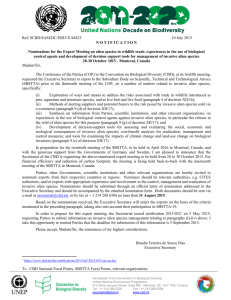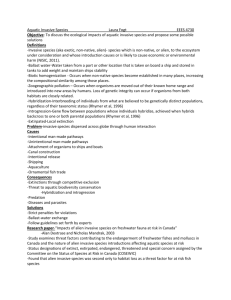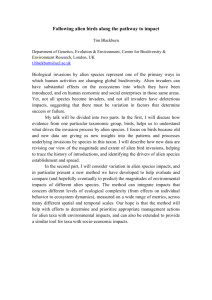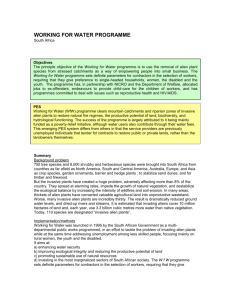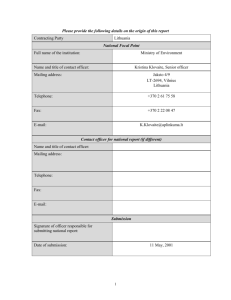Progress Report on Capacity-Building Workshops for the Global
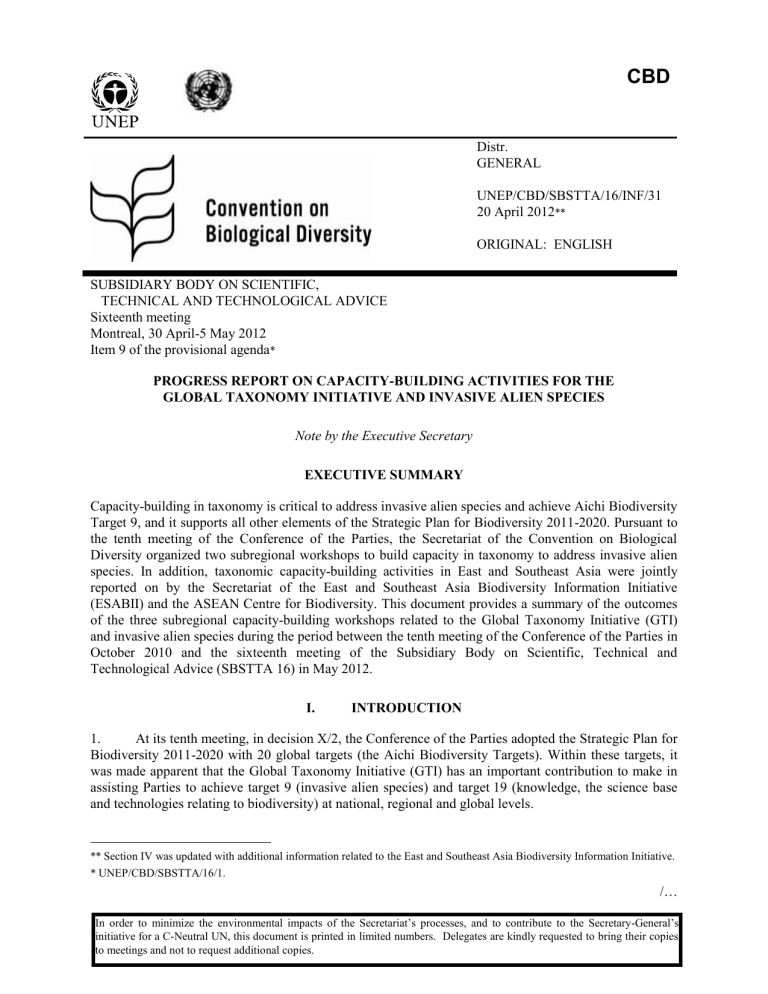
CBD
Distr.
GENERAL
UNEP/CBD/SBSTTA/16/INF/31
20 April 2012 **
ORIGINAL: ENGLISH
SUBSIDIARY BODY ON SCIENTIFIC,
TECHNICAL AND TECHNOLOGICAL ADVICE
Sixteenth meeting
Montreal, 30 April-5 May 2012
Item 9 of the provisional agenda *
PROGRESS REPORT ON CAPACITY-BUILDING ACTIVITIES FOR THE
GLOBAL TAXONOMY INITIATIVE AND INVASIVE ALIEN SPECIES
Note by the Executive Secretary
EXECUTIVE SUMMARY
Capacity-building in taxonomy is critical to address invasive alien species and achieve Aichi Biodiversity
Target 9, and it supports all other elements of the Strategic Plan for Biodiversity 2011-2020. Pursuant to the tenth meeting of the Conference of the Parties, the Secretariat of the Convention on Biological
Diversity organized two subregional workshops to build capacity in taxonomy to address invasive alien species. In addition, taxonomic capacity-building activities in East and Southeast Asia were jointly reported on by the Secretariat of the East and Southeast Asia Biodiversity Information Initiative
(ESABII) and the ASEAN Centre for Biodiversity. This document provides a summary of the outcomes of the three subregional capacity-building workshops related to the Global Taxonomy Initiative (GTI) and invasive alien species during the period between the tenth meeting of the Conference of the Parties in
October 2010 and the sixteenth meeting of the Subsidiary Body on Scientific, Technical and
Technological Advice (SBSTTA 16) in May 2012.
I. INTRODUCTION
1.
At its tenth meeting, in decision X/2, the Conference of the Parties adopted the Strategic Plan for
Biodiversity 2011-2020 with 20 global targets (the Aichi Biodiversity Targets). Within these targets, it was made apparent that the Global Taxonomy Initiative (GTI) has an important contribution to make in assisting Parties to achieve target 9 (invasive alien species) and target 19 (knowledge, the science base and technologies relating to biodiversity) at national, regional and global levels.
** Section IV was updated with additional information related to the East and Southeast Asia Biodiversity Information Initiative.
* UNEP/CBD/SBSTTA/16/1.
/…
In order to minimize the environmental impacts of the Secretariat’s processes, and to contribute to the Secretary-General’s initiative for a C-Neutral UN, this document is printed in limited numbers. Delegates are kindly requested to bring their copies to meetings and not to request additional copies.
UNEP/CBD/SBSTTA/16/INF/31
Page 2
2.
In the same decision, Parties were urged to review and, as appropriate, update and revise their national biodiversity strategies and action plans (NBSAPs), in line with the Strategic Plan and the guidance adopted in decision IX/9.
3.
To facilitate the implementation of the Strategic Plan (decision X/2), the Conference of the
Parties requested the Executive Secretary, in collaboration with Parties, other Governments and relevant international organizations, to provide support for regional and/or subregional workshops on updating and revising NBSAPs, the mainstreaming of biodiversity and the enhancement of the clearing-house mechanism (decision X/5).
4.
In light of the decisions mentioned in paragraphs 1 to 3 above, the Secretariat of the Convention on Biological Diversity organized subregional workshops to facilitate taxonomic capacity-building
(decisions VIII/3, IX/22 and X/39) and the development/updating of NBSAPs in the context of the
Global Taxonomy Initiative and invasive alien species (e.g., national invasive species strategies and action plans, NISSAPs). The rationale for the workshops was as follows:
(a) Taxonomic information is essential to detect, manage, and control invasive alien species.
Misidentifications can waste valuable resources when rapid decisions need to be taken. Capacity to find and apply taxonomic information tools is a basic need in both developed and developing countries;
(b) Engagement of taxonomic experts in information provision to all stakeholders is critical to identify and prioritize invasive alien species, and to control and eradicate them in every country;
(c) Communication between focal points/national authorities who work for biodiversity policymaking and taxonomic experts facilitates implementation of decisions relevant to the GTI and invasive alien species, and ensures science-based national planning. Scientifically sound national invasive species strategies and action plans can thus be developed and effective measures will be put into place;
(d) With the premises above, the workshops will support Parties toward achievement of
Aichi Biodiversity Target 9 (invasive alien species) and Target 19 (biodiversity knowledge and science), and the programme of work for the GTI will be implemented in timely manner.
5.
Two subregional workshops were held in 2011, organized by the Secretariat of the Convention on Biological Diversity with support from the Japan Biodiversity Fund: a workshop for Latin American countries, in Spanish, was held 12-13 November 2011 in Montreal 1 (see section II below) and an
English-language subregional workshop for Africa was held from 7 to 9 December 2011 in Nairobi 2 (see section III).
3
6.
A third subregional workshop was held in 5-6 March 2012 in Hanoi under the auspices of the
Government of Japan. It was organized by the East and Southeast Asia Information Initiative (ESABII) and the ASEAN Centre for Biodiversity 4 and was attended by the Secretariat. See section IV below for background on the workshop and related work.
1 http://www.cbd.int/doc/?meeting=RWIAST-LAM-01 .
2 http://www.cbd.int/doc/?meeting=WSCBIAS-AFR-01 .
3 A French-language subregional workshop for Africa is planned for a later date.
4 Planning and Inception Workshop: Expanded Taxonomic Capacity Building and Governance for Conservation and Sustainable
Use of Biodiversity.
/…
UNEP/CBD/SBSTTA/16/INF/31
7.
target 9 (invasive alien species).
Page 3
Section V provides a summary of the progress on taxonomic capacity-building as it relates to
II. SUBREGIONAL WORKSHOP ON TAXONOMY AND INVASIVE ALIEN
SPECIES FOR LATIN AMERICAN COUNTRIES
8.
The subregional workshop for Latin American countries was held on 12-13 November 2011 in
Montreal, Canada, in collaboration with the Food and Agriculture Organization of the United Nations
(FAO) and with the generous support of the Japan Biodiversity Fund. As indicated in the concept note for the workshop, participants considered how the draft capacity-building strategy for the Global
Taxonomy Initiative 5 could support Aichi Biodiversity Target 9 (invasive alien species) and
Target 19 (improvement and sharing of biodiversity-related knowledge and science). Participants included focal points for the Convention on Biological Diversity and the GTI, a national authority for fisheries, technical experts from taxonomic institutions, and representatives from non-governmental organizations working on invasive alien species.
9.
The following Parties and organizations participated in the workshop: Argentina, Brazil,
Colombia, Cuba, Dominican Republic, Ecuador, Guatemala, Honduras, Mexico, Uruguay, Venezuela,
Brazil’s Ministry of Fisheries and Aquaculture, the Comisión Nacional para el Conocimiento y Uso de la
Biodiversidad (CONABIO), the Horus Institute for Environmental Conservation and Development, the
Instituto Nacional de Biodiversidad de Costa Rica (INBio), Island Conservation, and Congruence LLC.
10.
Relevant documents, including the report of recommendations from the workshop, can be accessed on the meeting’s website at http://www.cbd.int/doc/?meeting=RWIAST-LAM-01 .
11.
The Secretariat provided a concept note 6 prior to the workshop with suggested goals as follows:
(a) Identify the necessary taxonomic information, tools and capacity-building needs to address threats to biodiversity posed by invasive alien species;
(b) Identify opportunities and challenges regarding sustainable use of biodiversity through collaboration of the focal points of the Convention and of the Global Taxonomy Initiative, and national authorities for fisheries, as Parties have been urged to implement the existing codes of conduct relevant to control one of the introduction pathways of alien species, aquaculture (paragraphs 20 to 23 of decision
VIII/27);
(c) Explore options to integrate such elements into the updated national biodiversity strategies and action plans (NBSAPs), as well as regional biodiversity strategies and action plans
(RBSAPs), as a contribution to implementation of the Strategic Plan for Biodiversity 2011-2020.
12.
Observations by workshop participants included the following:
(a) Participants noted the need to build capacity in taxonomic knowledge and species identification skills to effectively address invasive alien species; accurate species identification is
5 The draft capacity-building strategy for the Global Taxonomy Initiative, annexed to UNEP/CBD/SBSTTA/15/5, was welcomed at the fifteenth meeting of Subsidiary Body on Scientific, Technical and Technological Advice (SBSTTA 15). Following a peer-review process, the revised draft capacity-building strategy for the Global Taxonomy Initiative
(UNEP/CBD/SBSTTA/16/12) was made available for consideration and finalization by the Subsidiary Body at its sixteenth meeting (SBSTTA 16).
6 http://www.cbd.int/doc/meetings/ais/rwiast-lam-01/official/rwiast-lam-01-01-en.pdf
.
UNEP/CBD/SBSTTA/16/INF/31
Page 4 required for prevention strategies, including analysis of risk, pathways and vectors, early detection and rapid response, prioritization of measures, control, and eradication;
(b) Establishment of centres of excellence in biodiversity sciences would facilitate effective management and dissemination of taxonomic information. The workshop participants expressed the view that model institutions for such activities exist in the region, namely INBio in Costa Rica, CONABIO in
Mexico, and the Humboldt Institute in Colombia. These institutions support decision-making by governments and advise on conservation and management challenges, with strong taxonomic capacity that can be used by various sectors from national governments to local communities;
(c) It was found that insufficient institutional integration could act as an obstacle to effective management. However, given the heterogeneity of the institutions within the countries, development of national repositories of biodiversity information may not necessarily be appropriate in all of the institutions;
(d) Strengthening biological collections, increasing human resources and improving infrastructure would be beneficial. Some countries referred to relevant national initiatives to encourage the digitization of information, a task that the Inter-American Biodiversity Information Network (IABIN) also carried out with its member countries;
(e) Publication of taxonomic work in Spanish and Portuguese was suggested, as well as maximizing the use of relevant scientific journals available in different Latin American countries.
13.
With regards to aquaculture, participants noted that:
(a) Beyond its productive benefits, aquaculture has been and remains one of the critical pathways of introduction that needs to be controlled; escapes from aquaculture facilities can become invasive alien species in aquatic environments;
(b) Some species introduced for the purpose of aquaculture have become established in natural environments, with significant impacts on biodiversity and the traditional use of fishery resources;
(c) Risk analysis covering ecological and genetic risks as well as socio-economic risks and potential benefits should be conducted prior to introduction of alien species or translocation of species.
Participants also encouraged the production of indigenous/native species with the support of international development agencies and governments.
14.
Participants made the following observations in the context of invasive alien species prevention, eradication, and control. They gave particular attention to the invasive alien species issue as it relates to taxonomic capacity-building and NBSAPs/NISSAPs.
Possible strategies and action plans to address invasive alien species
(a) The problem posed by invasive alien species as agents of biodiversity loss is substantial.
In the absence of appropriate measures for prevention, control and eradication, extinctions of both plants and animals will continue to be driven by the spread and impact of invasive alien species;
(b) National committees focused on invasive alien species, which ideally involve authorities from different ministries/sectors (for instance biodiversity and environment, agriculture, fisheries and aquaculture, health, education), have proven quite valuable in addressing invasive alien species. Brazil,
/…
UNEP/CBD/SBSTTA/16/INF/31
Page 5
Chile and Uruguay have created such committees, and other countries in Latin America believe they could benefit from the experience of these examples;
(c) It is essential to include local communities in the management of invasive alien species and the implementation of local action plans. The involvement of different stakeholders in the planning and management of invasive alien species is more cost-effective, viable and sustainable in the long term.
Participants stressed the importance of training key stakeholders (e.g., academics, scientists, those working with biological collections, customs agents, technicians and authorities in the fisheries and agriculture sectors, etc.) but also the value of outreach to the community as a whole;
(d) Participants encouraged countries that did not already have NISSAPs to begin their development, making sure to include relevant linkages to the GTI programme of work. Two reports on invasive alien species in South America produced by the Global Invasive Species Programme (GISP) in
2001 and 2007 were identified as valuable resources in this regard; 7
(e) Economic assessments of the impacts of invasive alien species are very valuable to raising awareness of and support for the invasive alien species issue, as well as for identifying cost-effective approaches to the problem;
(f) The IABIN Invasives Information Network (I3N) risk analysis model has been successfully applied in countries such as Argentina, Brazil and Colombia. The initiative has included training courses, a standardized database on invasive alien species, risk assessment protocols for new and introduced species, invasion vector and pathway assessment tools, and priority-setting tools to control species that are already invasive. Mechanisms to secure the programme’s long-term operability, expansion and consolidation of I3N are urgently needed. Mexico has also developed an effective risk analysis tool. These initiatives could serve as models for use in other countries in the region and beyond;
(g) Successful examples of eradication of invasive alien species on islands were shared among participants. The participants recognized a need for this work to continue and to be expanded to other islands in the region as a matter of urgency;
Other important outcomes
(h) Participants pointed out that GISP had played a very important role in building the information capacity to address invasive alien species in Latin America. They unanimously recommended that resources and support be provided to fully restore this initiative;
(i) Some countries in the region have received support from the Global Environment
Facility (GEF) to address invasive alien species. Participants recommended that a mechanism be developed for sharing the “lessons learned” (including the project development process, project implementation, and project outcomes);
Capacity-building in taxonomy necessary to address invasive alien species
(j) Lack of continuity in national authorities relevant to taxonomic capacity-building was highlighted. This problem could be attenuated by supporting the work of the technical sectors in each institution and, in particular, supporting their participation in international forums. It is essential to establish and maintain linkages between the scientific and technical sectors and national focal points to ensure that technical recommendations translate into political decisions and concrete actions;
7 GISP closed in 2011. At the time this document was being produced, the website ( http://www.gisp.org
) was not available.
UNEP/CBD/SBSTTA/16/INF/31
Page 6
(k) National invasive species lists, which can be used as a framework for the regulation and management of problems associated with invasive alien species, need to be based on high-quality taxonomic information;
(l) All national organizations that promote science should explicitly budget for projects that address the information needs identified in NBSAPs. This was perceived as important to strengthening scientific capacity in key areas of taxonomy and the management of invasive alien species in countries in the region. Small grants can play an essential role in the digitization of data, as well as to ensure its accessibility and preservation;
(m) The repatriation of taxonomic information could strengthen biological collections and local knowledge;
(n) Web-based courses have been used to provide intensive training for taxonomy technicians. This activity has stimulated the review of collections. Such courses were identified as a very efficient way to build capacity for crucial taxonomic issues;
(o) Participants also pointed to emerging taxonomic tools, such as environmental DNA sampling, as potentially useful in the context of invasive alien species. They stressed the need to carefully evaluate the scope and limitations of new tools.
15.
The conclusions arising from this workshop were submitted to the regional workshop for
Mesoamerica on updating national biodiversity strategy and action plans held in San José, Costa Rica from 28 November to 2 December 2011. See information document UNEP/CBD/WS-IAS-
GTI/LA/1/INF/1.
16.
In addition, the FAO Committee on Fisheries (COFI) Sub-Committee on Aquaculture meeting held in Cape Town, South Africa, from 26 to 30 March 2012 considered the outcome of this workshop in the context of updating the “Code of Conduct for Responsible Fisheries”.
III. SUBREGIONAL WORKSHOP IN AFRICA TO STRENGTHEN CAPACITY FOR
INVASIVE ALIEN SPECIES AND TAXONOMY
17.
An English-language African subregional capacity-building workshop was held in Nairobi from
7 to 9 December 2011 to strengthen capacity relevant to invasive alien species, with the generous support of the Japan Biodiversity Fund. The workshop was organized by the Secretariat of the Convention on
Biological Diversity in collaboration with the International Union for Conservation of Nature Eastern and Southern Africa Regional Office. The participating organizations (see below) provided valuable information during the course of the workshop; their contributions are gratefully acknowledged.
18.
The following Parties and organizations participated in the workshop: Botswana, Egypt,
Ethiopia, Gambia, Japan, Kenya, Lesotho, Liberia, Malawi, Mozambique, Nigeria, South Africa, Sudan,
Swaziland, Uganda, the United Republic of Tanzania, Zimbabwe, the United Nations Environment
Programme (UNEP), the International Union for Conservation of Nature ( IUCN), the World
Organisation for Animal Health (OIE), CAB International, the International Centre of Insect Physiology and Ecology (ICIPE), the Japan International Cooperation Agency (JICA), the National Museums of
Kenya and Congruence LLC.
19.
Participants were nominated by the national focal points of the Convention on Biological
Diversity. All participants are undertaking national measures to address invasive alien species within
/…
UNEP/CBD/SBSTTA/16/INF/31
Page 7 their Governments or in academic institutions that support government initiatives. Two individuals joined the workshop from indigenous and local communities.
20.
Relevant documents, including the report with recommendations resulting from the workshop, can be accessed on the meeting’s website at http://www.cbd.int/doc/?meeting=WSCBIAS-AFR-01 .
21.
The workshop was intended to build capacity to address invasive alien species and contribute to the fulfilment of Aichi Biodiversity Target 9 and other relevant targets in the African region.
The
Secretariat provided a concept note prior to the workshop, 8 which proposed topics for discussion as follows:
(a) Exchange and active learning among the focal points and others regarding the current status of implementation to address invasive alien species, including the status of NISSAPs, and sharing of best practices in the region;
(b) Identify capacity needs for achieving Aichi Biodiversity Target 9 and other relevant targets, and review taxonomic capacity in the region to explore options to integrate such elements into
NBSAPs;
(c) Suggest the way forward to address invasive alien species.
22.
The workshop participants exchanged experiences and information on the status of implementation to address invasive alien species. Major findings of this discussion included the following:
(a) Many countries have developed NBSAPs with some reference to invasive alien species.
However, there are still some countries without NBSAPs and/or NISSAPs. This situation may make it difficult to establish effective prevention, control and management measures for invasive alien species at national boundaries;
(b) National legislation relevant to address invasive alien species often refers to “pests” and
“weeds”. The invasive alien species issue as a whole has not been sufficiently acknowledged or addressed in most countries;
(c) Invasive alien species have a direct link to poverty. Awareness-raising is urgently needed on the linkages between poverty, invasive alien species and climate change. The economic empowerment of indigenous and local communities, which often largely depend on natural resources for their livelihoods, needs to consider the potential near- and long-term ramifications of utilizing invasive alien species;
(d) Due to short-term funding cycles from external donors, African countries are often unable to invest adequately in long-term sustainable solutions;
(e) The effectiveness of eradication or control measures largely depends on the specific context and available financial resources. The cost of eradication can be extremely high and its success rate tends to be low. Prevention is thus very important and it should be considered as a worthwhile investment by governments and donors;
(f) Biocontrol can be a useful tool in addressing some invasive alien species. Adequate risk assessments should be undertaken prior to the introduction of biocontrol agents. While risk assessments
8 The concept note is accessible at http://www.cbd.int/doc/meetings/ais/wscbias-afr-01/official/wscbias-afr-01-01-en.pdf
.
UNEP/CBD/SBSTTA/16/INF/31
Page 8 are useful, there is a strong need for more guidance and support for capacity-building (training, tools, etc.) for national governments to be able to implement them. Host specificity experiments, involving target and not-target species (including closely related species), need to be carried out in order to rule out undesirable non-target effects. To conduct such experiments, taxonomic capacity may need to be enhanced;
(g) Indigenous people often cross national boundaries without knowing that they may be transporting invasive alien species. Indigenous and local communities may need to be more actively involved in programmes relevant to invasive alien species. Clearly awareness-raising among indigenous and local communities is an important aspect of addressing the invasive alien species issue.
23.
The workshop participants presented best practices in taxonomic capacity-building as well as the existing capacity to address invasive alien species in Africa. The capacity needs to achieve Aichi
Biodiversity Target 9 and other relevant targets were discussed. Major findings included the following:
(a) Access to relevant information is often a barrier to developing and implementing
NBSAPs and NISSAPs. Effective communication and partnerships are necessary: Parties cannot implement NBSAPs and NISSAPs without sufficient information on invasive alien species. Training of focal points on the NBSAP revision process, as is provided by the Secretariat of the Convention on
Biological Diversity, is essential;
(b) The draft document “Considerations for Implementing International Standards and
Codes of Conduct in National Invasive Species Strategies and Plans” is recognized as a useful tool for reviewing the existing NBSAPs and updating them;
(c) Taxonomic and specimen databases, as well as an interoperable network of other information resources, are essential to the early detection of and rapid response to biological invasions;
(d) Increased capacity, especially for developing countries, is necessary to identify, record and monitor invasions. Information needs exist with regards to (i) accessible lists of potential and established invasive alien species; (ii) potential threats to neighboring countries; and (iii) the taxonomy, ecology, genetics and control methods of each alien species;
(e) To maximize the effectiveness of various measures to address invasive alien species, coordination and communication are needed between environment and agriculture ministries, as well as between Parties and supporting scientific institutions. Ideally, a coordination mechanism should be established at national level. Internationally, it is expected that the Inter-Agency Liaison Group on
Invasive Alien Species could be of service;
(f) Access to information in databases was also considered a priority. Portals such as the
Global Biodiversity Information Facility (GBIF) and the Global Invasive Species Information Network
(GISIN) were identified as useful, but struggling financially. There is a need to explore approaches for identifying and linking regional databases. The participants wanted to encourage the joint work programme on invasive alien species (UNEP/CBD/SBSTTA/15/INF/14) 9 to support the informatics needs of the Africa region by identifying/linking existing databases. These databases may include information on native, introduced, and naturalized flora that is available in published flora series, for instance the Flora of Tropical East Africa, Flora of Tropical West Africa, Flora Zambeziaca (for
Southern Africa), Flora of Ethiopia, and Flora of Somalia;
9 https://www.cbd.int/doc/meetings/sbstta/sbstta-15/information/sbstta-15-inf-14-en.pdf
.
/…
UNEP/CBD/SBSTTA/16/INF/31
Page 9
(g) There is great potential for regional project development to improve taxonomic capacity among African subregional groups. Organizations such as the Southern African Development
Community (SADC) and the East African Community (EAC) could take a lead in project development.
The SADC has an invasive alien species programme. The Common Market for Eastern and Southern
Africa (COMESA) may need to develop a new programme on invasive alien species; the risk of movement of invasive alien species across Africa will increase as vehicles, goods, and people begin moving more freely;
(h) African countries should make use of the data already available, for example, the information disseminated by the South African National Biodiversity Institute (SANBI) and others. It is also possible to learn lessons from them on commitment, political will and the importance of the involvement of all stakeholders;
(i) The loss of BioNET INTERNATIONAL (BioNET) and GISP, both programmes which would have contributed to more effective capacity-building activities in the region, was noted.
Participants felt there was an urgent need to identify the gaps created by termination of these organizations to find a means to fill the gaps at national and regional levels.
24.
The workshop participants discussed the way forward to address invasive alien species. The
Secretariat, in collaboration with workshop participants, prepared a report with recommendations from the workshop (UNEP/CBD/WS-CB-IAS-AFR/1/2).
10 This document includes the following points:
The NBSAP updating process
(a) It is important to proactively inform stakeholders (including governments, farmers, cities, indigenous and local communities, private sector, the scientific research community, and fund donors, among others) about NBSAP and NISSAP processes, in order to contribute to the identification of issues relevant to invasive alien species and taxonomy, alleviate concerns, and garner support for the measures implemented, as well as establishment of partnerships;
(b) Assessments of economic impacts caused by invasive alien species need to be conducted.
The results may help to develop political will to address invasive alien species, especially with regards to poverty reduction in the region. Disseminating information on impacts of invasive alien species on ecosystems and ecosystem goods and services, including economic livelihoods, is needed for garnering attention from policymakers and donors. It is also important to inform policymakers that addressing invasive alien species (e.g., through mechanical removal of invasive weeds) can create opportunities for addressing unemployment and poverty reduction;
(c) Political commitment to addressing invasive alien species should be clearly stated in
NBSAPs. Commitments need to come from within the countries, preferably from the highest levels of government. To ensure implementation of planned actions in NBSAPs, countries must be very vocal in expressing their needs for financial support both from the domestic government and from external funding sources;
(d) Better coordination/communication is needed between environment and agriculture ministries, as well as between ministries and supporting scientific institutions. Coordination mechanisms need to be established at the national level;
10 http://www.cbd.int/doc/meetings/ais/wscbias-afr-01/official/wscbias-afr-01-02-en.pdf
.
UNEP/CBD/SBSTTA/16/INF/31
Page 10
Effective capacity-building in Africa
(e) African countries need to build systems as “capacity development” that are self-sustaining. Some countries have a biosecurity system that is able to support itself through collecting permit fees and fines. These “best practices” can be shared in the region;
(f) Guidance and technical support are needed for developing and conducting risk analysis systems specifically for invasive alien species impacts on biodiversity;
(g) Concerning the loss of the support previously provided by BioNET INTERNATIONAL and GISP, the international community, principally Parties, donors and other interested organizations, should urgently consider how to fill the resulting gaps in technical support;
(h) A capacity-building package on taxonomy, linked to GTI, is needed in a timely manner to support the implementation of Aichi Biodiversity Targets;
(i) Further action to improve taxonomic capacity-building should include training in relevant technical skills; development of NISSAPs, risk analysis and pathway management; communication, education and public awareness (CEPA) programmes; and a regional roster of taxonomic experts;
Information sharing
(j) The joint work programme on invasive alien species
(UNEP/CBD/SBSTTA/15/INF/14) 11 was recognized as a potential benefit to improving invasive alien species information in the African region. The workshop participants expressed to the organizations mentioned in the joint work programme their hope for support and prioritization of the relevant information needs of the region;
(k) The suggestion was made to develop a notification process for IAS entry/establishment akin to the OIE disease notification system. A notification process could be instrumental in warning other/neighbouring countries that there is impending danger/threat and measures to prevent invasions should be taken to prevent introduction and invasion;
Regional cooperation
(l) Participants found that agencies often operate in isolation, with little or no exchange of information or sharing of resources. Cooperation, including South-South cooperation, should be encouraged. Regional cooperation is especially needed in the fight against invasive alien species.
Countries need to consider that when they share water bodies, their actions affect neighbouring and downstream countries;
(m) Parties in Africa should consider the development of regional networks to facilitate sharing of information and best practices for the implementation of the programme of work on invasive alien species (including pathways of introduction) in line with Aichi Biodiversity Target 9;
(n) Neighbouring countries, and all countries along a particular pathway for invasive alien species, should be able to recognize invasive alien species and concur on their nomenclature. Baseline
11 https://www.cbd.int/doc/meetings/sbstta/sbstta-15/information/sbstta-15-inf-14-en.pdf
.
/…
UNEP/CBD/SBSTTA/16/INF/31
Page 11 taxonomic information on native biota at the national level is important to ensure that invasive alien species can be recognized and distinguished from naturally present species;
(o) There is potential for cooperation among the standard subregional groups such as SADC and EAC. SADC already has an invasive alien species programme. COMESA may need to develop a new programme on invasive alien species, as there will be movement across Africa with freer movement of vehicles, goods and people;
Global cooperation
(p) Parties should designate or assign a contact point for the programme on invasive alien species to relevant ministries and stakeholders to implement Article 8(h) of the Convention on Biological
Diversity, decisions under the Convention, and particularly Aichi Biodiversity Target 9;
(q) The workshop participants were encouraged to review the information on the Liaison
Group and to consider making recommendations, as Parties that support the work of this group, in terms of national capacity-building for multisector collaboration;
(r) A request was made for further guidelines/decision-support tools on the wise and cautious utilization of invasive alien species.
25.
The workshop participants requested that the outcome of this workshop be considered at the regional workshop for Africa on updating national biodiversity strategies and action plans (NBSAPs) to be held in Addis Ababa from 27 February to 1 March 2012.
26.
The Secretariat of the Convention on Biological Diversity informed participants that decision VI/23
*
and other relevant decisions of the Conference of the Parties on invasive alien species repeatedly mentioned regional cooperation. Participants raised the possibility of formalizing regional cooperation, through the Conference of the Parties, as a way to achieve Aichi Biodiversity Target 9 of the
Strategic Plan for Biodiversity 2011-2020.
IV. TAXONOMIC CAPACITY-BUILDING IN EAST AND SOUTHEAST ASIA
27.
The Japan-ASEAN Integration Fund (JAIF) supported a project on taxonomic capacity-building and governance for sustainable use of biological diversity, implemented from July 2010 to June 2011.
This work is continuing, and a workshop on expanded taxonomic capacity-building and governance for conservation and sustainable use of biodiversity was held in Hanoi, Viet Nam, on 5-6 March 2012 under the auspices of the Government of Japan. The national focal points for the Convention on Biological
Diversity and for GTI and ESABII (East and Southeast Asia Biodiversity Information Initiative) focal points, as well as ASEAN focal points, were invited to the workshop.
28.
Parties and observers that participated in the workshop included Brunei Darussalam, Cambodia,
China, Indonesia, Japan, the Lao People’s Democratic Republic, Malaysia, Myanmar, Philippines,
Singapore, Thailand, Viet Nam, the ASEAN Secretariat, the ASEAN Centre for Biodiversity, the Nagao
Natural Environment Foundation, BirdLife International, the Japan Wildlife Research Center, the Japan
International Cooperation Agency (JICA), TRAFFIC Southeast Asia, TRAFFIC East Asia-Japan,
* One representative entered a formal objection during the process leading to the adoption of this decision and underlined that he did not believe that the Conference of the Parties could legitimately adopt a motion or a text with a formal objection in place. A few representatives expressed reservations regarding the procedure leading to the adoption of this decision (see
UNEP/CBD/COP/6/20, paras. 294-324).
UNEP/CBD/SBSTTA/16/INF/31
Page 12
Biodiversity Center of Japan of the Ministry of the Environment as the ESABII Secretariat, and the
Secretariat of the Convention on Biological Diversity.
29.
The purpose of the workshop was to review the progress on implementation of the programme of work for the GTI in 2010-2011 and to develop the action plans for the period of 2012-2013.
30.
The following information was submitted by the ASEAN Centre for Biodiversity.
Progress in 2010-2011
31.
Activities in 2010-2011 included a planning workshop and four training workshops in collaboration with ESABII, and two internship programmes held at major taxonomic institutions in the
ASEAN region, and networking of GTI national focal points.
32.
The internship programmes, both held in Thailand, were designed for 32 days of taxonomic training on dicots and corals respectively. The dicots taxonomy internship was held at the Royal Forestry
Herbarium in Bangkok, and the coral taxonomy internship was held at the Phuket Marine Biology Center in Phuket. Priority countries that attended the internship programmes were Cambodia, the Lao People’s
Democratic Republic, Myanmar, Viet Nam, and Thailand. Participants were given the assignment of selecting their species of interest, received hands-on training on how to handle and describe the specimens, and obtained skills in writing taxonomic articles in publishable form .
33.
The internship programmes trained 110 individuals, mostly young taxonomists, from the 10
ASEAN Member States with addition of 10 participants from Japan, and 2 from China.
34.
Three training manuals were also developed (dicot taxonomy, coral taxonomy, and training of trainers for Convention on International Trade in Endangered Species of Wild Fauna and Flora (CITES) policies and identification of threatened species).
35.
“Friends of Biodiversity”, a web-based database to develop a roster of biodiversity scientists
(envisaged to cover taxonomic experts, biodiversity scientists, relevant academicians, government officials, and other interested parties), was developed for the Southeast Asia region. It is an interactive database wherein those interested in being included in the database can log in and enter their names, positions, agencies, and expertise. In addition, six press releases were disseminated in Southeast Asia to inform the public about taxonomic capacity-building activities in Southeast Asia.
36.
ESABII, as information initiative, gathered taxonomic information on migrant birds, threatened mammal species and threatened vascular plant species to populate the databases of ESABII. Experts from
ESABII presented progress at a side-event in the margins of the tenth meeting of the Conference of the
Parties in Nagoya in October 2010.
37.
ESABII was also involved in conducting the training of trainers (ToT) on CITES in Kuala
Lumpur in Malaysia. ESABII independently organized country-specific training workshop in Viet Nam with lectures who had participated in the previous ToT.
Plans for 2012-2013
38.
The Japan-ASEAN Integration Fund and the Ministry of the Environment of Japan as the
Secretariat of ESABII continue to support on expanded taxonomic capacity-building and governance for sustainable use of biodiversity in 2012.
/…
UNEP/CBD/SBSTTA/16/INF/31
Page 13
39.
Under Japan-ASEAN Integration Fund, training courses will be undertaken in (i) taxonomy of terrestrial plants, focused on monocots; (ii) taxonomy of freshwater fishes; and (iii) management of invasive alien species, including their taxonomy.
40.
An internship programme for the taxonomy of monocots is also planned. The components for
CEPA and information management and improvement of databases are also lined up for 2012.
41.
Regarding the target groups for the training workshop in 2013 and beyond, the workshop participants identified (i) a training course in taxonomy of terrestrial plants, namely bryophytes and pteridophytes, and (ii) a training course in taxonomy of insects. Subject to availability of funding, an internship programme would also be conducted.
42.
The ESABII workplan for 2012-2013 includes (i) country-specific training relevant to CITES and (ii) dissemination of biodiversity information through the ESABII portal (www.esabii.org/).
ESABII plans to further identify available and not-yet-digitized data resources, research institutes and organizations that can participate to the cooperative work of sharing information. ESABII will continue to support taxonomic capacity-building activities in Southeast Asia.
Project development in the ASEAN region
43.
The workshop considered project development in the ASEAN region for GTI capacity-building.
The group recognized that invasive alien species are the issue of regional common interest in this context. The growing network of the taxonomic institutions under ESABII may facilitate the process of project development regarding early detection and rapid response to invasive alien species, with coordination by the ASEAN Centre for Biodiversity.
44.
The workshop agreed to seek opportunities to develop a regional project through the LifeWeb
Initiative, with particular focus on invasive alien species management in ASEAN heritage areas
(protected areas in the region).
V. CONCLUSIONS
45.
Credible biological and ecological information on alien species and their potential impacts is essential for science-based risk analysis, and to assist regulatory decisions related to all pathways for the introduction of alien species. The programme of work for the GTI and the planned activities for invasive alien species, protected areas, and other thematic areas remain to guide the capacity-building in taxonomy.
46.
At each of the subregional workshops, participants were encouraged to report back on the workshop in their countries, to include issues relevant to invasive alien species and the GTI in their updated NBSAPs, and to contact the focal points of other environmental conventions to collaborate on issues relevant to invasive alien species and the GTI in an effort to encourage cross-sectoral communication.
47.
The multisectoral nature of the invasive alien species issue necessitates coordination among different ministries and agencies. Professional taxonomists can provide training and develop species identification tools to support Parties’ needs. Unfortunately, there is currently insufficient capacity among professional taxonomists and taxonomic institutions to support the necessary work invasive alien species. Further support to taxonomic institutions is vital.
48.
The Inter-Agency Liaison Group on Invasive Alien Species could support multisector coordination and capacity-building at national and regional levels. As requested by the English-language
UNEP/CBD/SBSTTA/16/INF/31
Page 14 subregional workshop for Africa, the Secretariat of the Convention on Biological Diversity should further explore such opportunities.
49.
The joint work programme on invasive alien species (UNEP/CBD/SBSTTA/15/INF/14) was welcomed by the English-language subregional workshop for Africa. The workshop participants explicitly requested that the organizations mentioned in the joint work programme support and prioritize the relevant information needs of the African region. Regional workshops for capacity-building could be a good opportunity for the organizations that provide information and identify information needs to address invasive alien species and further improve the coverage of information by locating local and regional invasive alien species information.
50.
The workshops above identified some leading taxonomic institutions that can support the Parties in achieving their Aichi Biodiversity Targets. The common features of these successful institutions included the following: (i) strong taxonomic capacity supported by large collections of specimens from the own regions and skilful taxonomists; (ii) close collaboration with the ministry or agency that is responsible for the implementation of the Convention on Biological Diversity; (iii) active database development and web-based data sharing; (iv) active international collaboration to advance taxonomic studies; and (v) North-South and South-South cooperation. Establishing and maintaining such institutions as “biodiversity centres of excellence” in each region is necessary to achieving Aichi Biodiversity
Targets.
51.
Participants in the subregional workshops expressed considerable concern over the loss of
BioNET INTERNATIONAL and GISP. Parties, other Governments and relevant organizations may wish to consider ways to revitalize these organizations.
52.
Participants in the workshops expressed further need for guidance and case-studies. Needs and existing capacity are different from one region to another, and effective capacity-building may require careful needs assessment and appropriate implementation tools. The development of resources such as the draft document Considerations for Implementing International Standards and Codes of Conduct in
National Invasive Species Strategies and Plans , the Standard Format for Taxonomic Needs and Capacity
Assessments for Use by Parties (UNEP/CBD/SBSTTA/15/INF/4), and the Guide to the Global
Taxonomy Initiative will be further advanced and customized to effectively conduct regional capacitybuilding workshops and follow-up events.
53.
The eleventh meeting of the Conference of the Parties to the Convention on Biological Diversity will be tasked with reviewing progress made to achieve the Aichi Biodiversity Targets of the Strategic
Plan, including target 9 and target 19. Several indicators, which were considered and recommended by
SBSTTA 15, will contribute to this assessment. Further review will be undertaken on NBSAPs at the twelfth meeting of the Conference of the Parties. It is expected that the Global Taxonomy Initiative and invasive alien species will have a stronger presence than in the past in updated NBSAPs, as well as in fifth national reports to be submitted by Parties by March 2014.
-----

